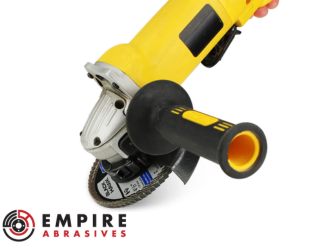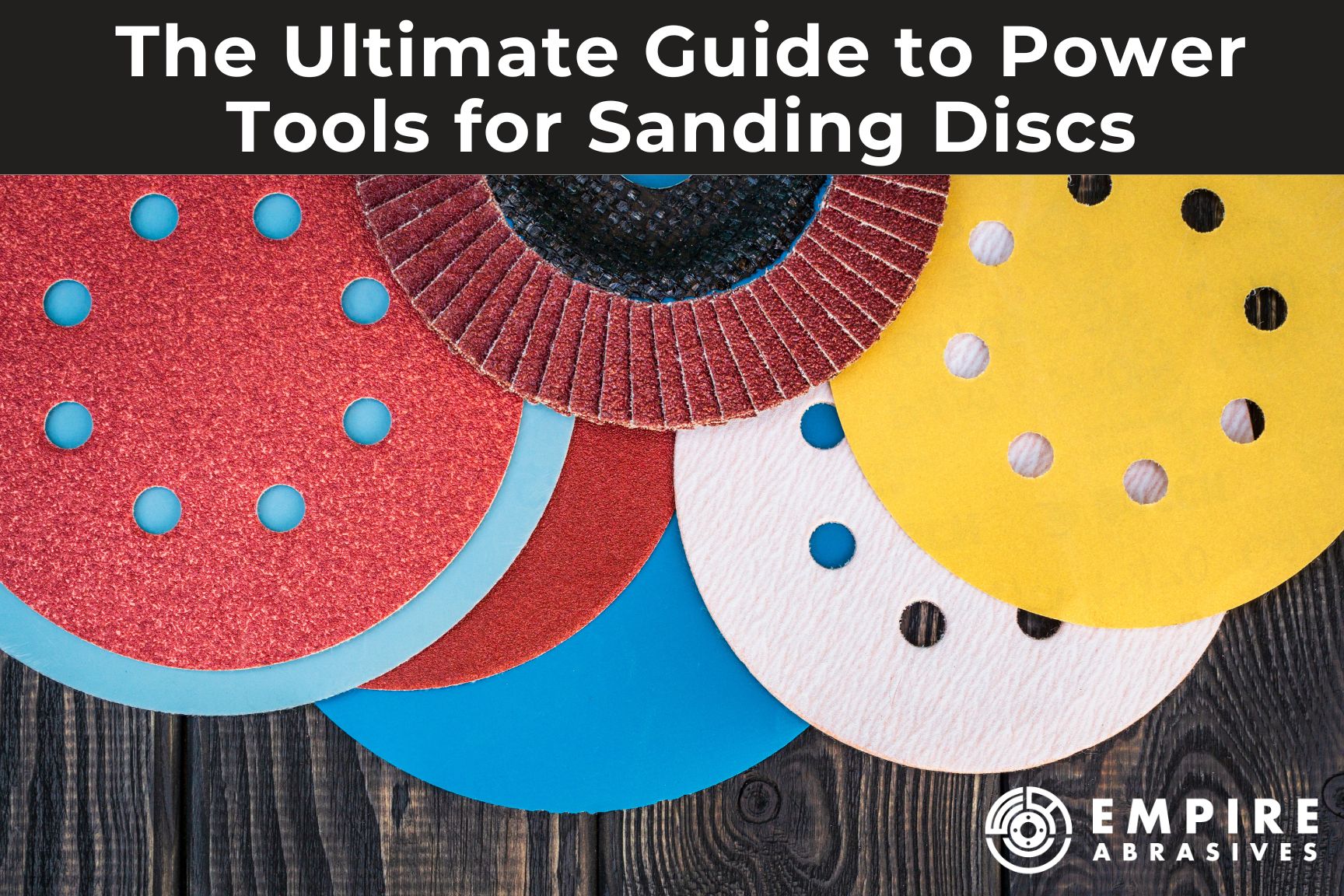
Sanding discs are the part of a sander that actually does all the hard work. At Empire Abrasives, we carry thousands of sanding discs. They range in size from 2 inches discs to 12 inches. Those all also come in a variety of different forms. Different power tools require specific types of sanding discs and are best suited for particular applications. This post breaks down the different power tools that you could find yourself attaching a sanding disc to, what they are best for, and compatible sanding discs for each tool.
1. Heavy-Duty Tools
These tools are powerful and designed for aggressive material removal and heavy-duty sanding tasks.
Angle Grinders
- Other Names: Right Angle Grinders, Side Grinders
- Overview: These are powerful handheld tools known for their versatility and ability to tackle tough jobs. With a spinning disc mounted at a 90-degree angle, they excel at cutting, grinding, and removing material from metal, wood, concrete, and other hard surfaces.
- Applications: Material removal, surface preparation, cutting, and polishing.
- Advantages: Powerful and versatile; ideal for heavy-duty tasks.
- Limitations: Usually too aggressive for delicate sanding tasks.
- Compatible Sanding Discs:
Rotary Sanders
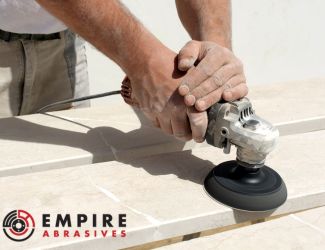
- Other Names: Handheld Disc Sander, Polisher, Rotary Buffer
- Overview: Rotary polishers/sanders are handheld power tools that have a circular pad that spins on a single axis at high speeds. They are mostly used for polishing and finishing, but some allow you to attach sanding discs.
- Applications: Stripping paint, surface prep, aggressive sanding, shaping wood.
- Advantages: Fast and efficient for large surfaces.
- Limitations: Can cause swirl marks; less precise than orbital sanders.
- Compatible Sanding Discs:
2. Medium-Duty Tools
These handheld power tools offer a mix of precision and power for various sanding tasks.
Stationary Disc Sanders
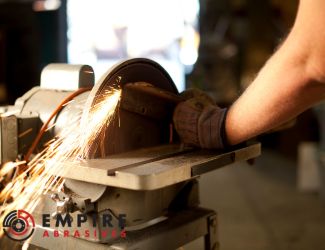
- Other Names: Disc Sanders, Bench-Top Disc Sanders, Table Sanders, Platen Disc Sanders
- Overview: These large sanding machines have a horizontal table with a rotating disc mounted on it. They offer stability and precision when sanding flat surfaces. These types of sanders are great for smoothing, edge work, and surface preparation on wood, metal, and other materials.
- Applications: Smoothing flat surfaces, edge work, surface prep.
- Advantages: Consistent and efficient for flat surfaces.
- Limitations: Stationary; not suitable for complex shapes.
- Compatible Sanding Discs:
Orbital Sanders (Including Random Orbital and DA Machines)

- Other Names: Dual Action Sanders (for Random Orbital)
- Overview: Orbital sanders, including random orbital sanders and DA machines, use an orbital motion instead of just spinning for sanding with minimal risk of swirl marks. These versatile tools are popular in both woodworking and auto bodywork.
- Applications: Finish sanding, smoothing surfaces, prep work.
- Advantages: Swirl-free finish; easy to use.
- Limitations: Less aggressive; not ideal for heavy material removal.
- Compatible Sanding Discs:
3. Precision Tools
Precision tools are designed for detailed and intricate work where accuracy is essential.
Die Grinders
- Overview: These precision tools are often electric or pneumatic powered. Die grinders are often used for detailed sanding and grinding tasks. Their small size and high control make them very useful for working in tight spaces and handling intricate jobs.
- Applications: Precision sanding, deburring, detailed grinding.
- Advantages: High control; ideal for tight spaces.
- Limitations: Not suitable for large areas or heavy-duty work.
- Compatible Sanding Discs:
Rotary Tools (e.g., Dremel)
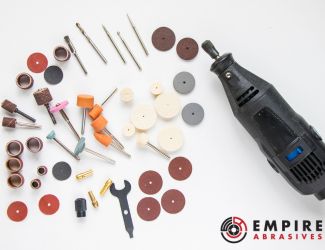
- Other Names: Multi-tools, High-Speed Rotary Tool, Hobby Tool
- Overview: Rotary tools, like Dremels, are incredibly versatile tools used for a wide range of detailed tasks from sanding and grinding to cutting and polishing. They are a favorite among hobbyists and DIYers for small-scale projects and working on intricate details.
- Applications: Crafting, detail sanding, small-scale repairs, polishing.
- Advantages: Versatile and compact; perfect for intricate tasks.
- Limitations: Not designed for large or heavy-duty jobs.
- Compatible Sanding Discs: 2” or 3” Sanding Discs
4. Multi-Use Tools
Power Drills
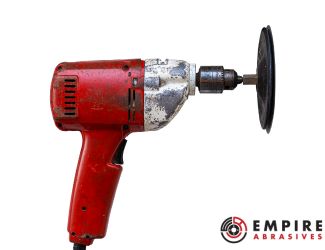
- Other Names: Drill Drivers, Cordless Drill, Right Angle Drills, Electric Drill
- Overview: Even though they are mostly used for drilling, they can be adapted to fit different kinds of sanding attachments. They offer great maneuverability, which is helpful for times that you might have a hard time fitting other types of sanders.
- Applications: Light to medium sanding, especially in hard-to-reach areas.
- Advantages: Multi-functional; easy to use; accessible for DIYers.
- Limitations: Less efficient for large or high-precision sanding compared to dedicated sanders.
- Compatible
Sanding Discs:
- Drill-Attached Sanding Discs
- Small Hook and Loop Sanding Discs
- Quick Change Discs
Attaching Sanding Discs to Power Tools
Different tools use specific sanding disc attachment methods like backing pads, mandrels, and specialized backing materials. Here’s a quick guide to the most common systems:
1. Hook-and-Loop (Velcro) Attachments
- What It Is: A Velcro-like looped fabric backing on the sanding disc attaches to a hook-covered pad on the tool.
- Common Tools: Orbital Sanders, Random Orbital Sanders, DA Machines, Polishers, Die Grinders.
- Pros: Quick and reusable.
- Cons: Less secure for heavy-duty tasks.
2. PSA (Pressure Sensitive Adhesive) Sticky Back
- What It Is: Discs have a sticky back that adheres to a smooth PSA backing pad on the tool.
- Common Tools: Disc Sanders, Rotary Sanders, Bench Grinders (with modifications).
- Pros: Strong hold; flat sanding surface.
- Cons: Single-use; sometimes difficult to remove.
3. Quick-Change (Roll-On or Roloc) Systems
- What It Is: Discs snap or twist on and off quickly using a specialized Roloc adapter.
- Common Tools: Die Grinders, Air Grinders.
- Pros: Fast changes; secure for high-speed work.
- Cons: Requires specific attachments.
4. Threaded/Spindle Attachments
- What It Is: Discs screw directly onto the tool’s threaded spindle.
- Common Tools: Angle Grinders, Air Grinders, Rotary Sanders, Bench Grinders.
- Pros: Very secure; handles heavy-duty work.
- Cons: Slower to change discs.
5. Mandrels and Collets
- What It Is: Small discs are attached by a shaft/mandrel or tightening mechanism.
- Common Tools: Rotary Tools (e.g., Dremel), Die Grinders.
- Pros: Precision control; versatile for small discs.
- Cons: Limited to smaller discs.
Conclusion
Choosing the right power tool for sanding discs can significantly impact the quality and efficiency of your work, whether you're a professional or a DIYer. From heavy-duty grinders to precision rotary tools, each tool has its own strengths and limitations, making it important to match the tool your given task.
The right attachments and adapters can further enhance the versatility of your tools, allowing you to tackle a wide range of sanding jobs with ease. Whether you're prepping a surface for paint, smoothing out rough edges, or polishing to a high shine, the right combination of tools and sanding discs will help you achieve the best results.
Explore the variety of sanding discs and attachments available at Empire Abrasives to find the perfect match for your project, and don't hesitate to reach out if you need any assistance selecting the right products.

